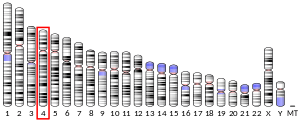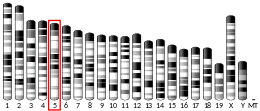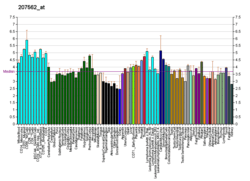DGKQ
Diacylglycerol kinase theta is an enzyme that in humans is encoded by the DGKQ gene.[5][6][7]
The protein encoded by this gene contains three cysteine-rich domains, a proline-rich region, and a pleckstrin homology domain with an overlapping Ras-associating domain. It is localized in the speckle domains of the nucleus, and mediates the regeneration of phosphatidylinositol (PI) from diacylglycerol in the PI-cycle during cell signal transduction.[7]
Interactions
DGKQ has been shown to interact with RHOA.[8]
gollark: Besides, communism doesn't make sense according to all philosophy.
gollark: What do you mean "perfect society"?
gollark: Fixed-point decimal numbers for currencies and such.
gollark: Matrices, again mathily.
gollark: Vectors, in the mathy sense, perhaps.
References
- GRCh38: Ensembl release 89: ENSG00000145214 - Ensembl, May 2017
- GRCm38: Ensembl release 89: ENSMUSG00000004815 - Ensembl, May 2017
- "Human PubMed Reference:". National Center for Biotechnology Information, U.S. National Library of Medicine.
- "Mouse PubMed Reference:". National Center for Biotechnology Information, U.S. National Library of Medicine.
- Endele S, Zabel B, Winterpacht A (Jun 1996). "Assignment of the human diacylglycerol kinase 4 (DAGK4) gene to chromosome 4p16.3". Genomics. 33 (1): 145–6. doi:10.1006/geno.1996.0174. PMID 8617502.
- Houssa B, Schaap D, van der Wal J, Goto K, Kondo H, Yamakawa A, Shibata M, Takenawa T, van Blitterswijk WJ (May 1997). "Cloning of a novel human diacylglycerol kinase (DGKtheta) containing three cysteine-rich domains, a proline-rich region, and a pleckstrin homology domain with an overlapping Ras-associating domain". J Biol Chem. 272 (16): 10422–8. doi:10.1074/jbc.272.16.10422. PMID 9099683.
- "Entrez Gene: DGKQ diacylglycerol kinase, theta 110kDa".
- Houssa, B; de Widt J; Kranenburg O; Moolenaar W H; van Blitterswijk W J (Mar 1999). "Diacylglycerol kinase theta binds to and is negatively regulated by active RhoA". J. Biol. Chem. 274 (11): 6820–2. doi:10.1074/jbc.274.11.6820. ISSN 0021-9258. PMID 10066731.
Further reading
- Sakane F, Kanoh H (1998). "Molecules in focus: diacylglycerol kinase". Int. J. Biochem. Cell Biol. 29 (10): 1139–43. doi:10.1016/S1357-2725(97)00037-X. PMID 9438377.
- Li D, Urs AN, Allegood J, et al. (2008). "Cyclic AMP-Stimulated Interaction between Steroidogenic Factor 1 and Diacylglycerol Kinase θ Facilitates Induction of CYP17". Mol. Cell. Biol. 27 (19): 6669–85. doi:10.1128/MCB.00355-07. PMC 2099220. PMID 17664281.
- van Baal J, de Widt J, Divecha N, van Blitterswijk WJ (2005). "Translocation of diacylglycerol kinase theta from cytosol to plasma membrane in response to activation of G protein-coupled receptors and protein kinase C". J. Biol. Chem. 280 (11): 9870–8. doi:10.1074/jbc.M409301200. PMID 15632189.
- Tabellini G, Bortul R, Santi S, et al. (2003). "Diacylglycerol kinase-theta is localized in the speckle domains of the nucleus". Exp. Cell Res. 287 (1): 143–54. doi:10.1016/S0014-4827(03)00115-0. PMID 12799190.
- Strausberg RL, Feingold EA, Grouse LH, et al. (2003). "Generation and initial analysis of more than 15,000 full-length human and mouse cDNA sequences". Proc. Natl. Acad. Sci. U.S.A. 99 (26): 16899–903. Bibcode:2002PNAS...9916899M. doi:10.1073/pnas.242603899. PMC 139241. PMID 12477932.
- Houssa B, de Widt J, Kranenburg O, et al. (1999). "Diacylglycerol kinase theta binds to and is negatively regulated by active RhoA". J. Biol. Chem. 274 (11): 6820–2. doi:10.1074/jbc.274.11.6820. PMID 10066731.
- Sakane F, Imai S, Kai M, et al. (1996). "Molecular cloning of a novel diacylglycerol kinase isozyme with a pleckstrin homology domain and a C-terminal tail similar to those of the EPH family of protein-tyrosine kinases". J. Biol. Chem. 271 (14): 8394–401. doi:10.1074/jbc.271.14.8394. PMID 8626538.
This article is issued from Wikipedia. The text is licensed under Creative Commons - Attribution - Sharealike. Additional terms may apply for the media files.




